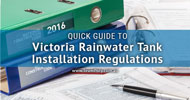
When installing a water tank, you need to make sure that all the work is conducted in accordance with state government specifications and requirements. In this article, we will look at regulations in the state of Victoria associated with rainwater tanks including general requirements, installation requirements and requirements often required by local authorities.
Install Requirements for Rainwater Tanks
The installation of water tanks in Victoria is regulated by Plumbing Code of Australia (PCA), which is a technical standard found in the National Construction Code (NCC). This Code endorses the Australian Plumbing and Drainage standards (AS/NZS 3500).
The 6 Star Standard found in the NCC requires rainwater harvesting systems to:
- have a minimum rainfall catchment area of 50m2,
- rainwater storage with a minimum capacity of 2,000 litres,
- rainwater storage connected to all flushing devices in all the toilets in the building in order to ensure use of the rainfall for sanitary flushing.
According to the Victorian Building Authority, Victorian variations to the energy provisions of the Building Code of Australia (found in Volume One and Two of the NCC) provide require new Class 1 buildings to either:
- install a rainwater tank that is connected all the sanitary flushing systems, or
- a solar water heater system.
Class 1 buildings are any single dwelling (a detached house) or one or more attached dwellings separated with a fire-resisting wall, and boarding or guest house, hostel or similar with a total floor area not exceeding 300m2 and where a maximum of 12 people reside. It also includes extensions or additions to Class 1 buildings that have roof area larger than 50m2 and that incorporate a water heater, water closer or laundry cold outlet.
Connection Requirements for Rainwater
The main install requirements for water tanks are reasonable and relatively easy to comply with. In Victoria, there are two types of requirements – connection related and backflow prevention related. A summary of both is given below:
What are the Connection Requirements?
- A continual supply of water provided by a manual or automatic device for switching between rainwater and mains water is needed.
- The installation of the water tank must be compliant with the AS/NZS 3500.1:2003, as well with the requirements for backflow containment of the local water authority.
- All the piping and connection systems, fixtures, appliances and outlets must be installed by a licensed plumber.
- All the pipes carrying rainwater need to be marked with the word “RAINWATER” in a contrasting colour and at intervals that do not exceed 1 metre. The water outlets must also be labelled with the word “RAINWATER”, and taps identified with an indicator marked with the letters “RW” in green colour.
What do you require for backflow prevention?
If the water tank is used for non-drinking purposes within the home, there should be an interconnection with the mains water. Be aware that there are a number of requirements for this interconnection:
- A device such as a dual check valve is needed to protect the rainwater from entering the mains supply
- A device for manual or automatic switching between rainwater and mains water is recommended
- A high hazard rated testable device to prevent water contamination is needed if the tank installed is partly or completely buried in the ground.
- A registry and commissioning by the local water authority of all containment testable prevention devices is needed prior to their usage. These devices must also be tested on an annual basis by a qualified plumber.
Compliance Certificate
A compliance certificate is a document required by the Victorian Building Authority (VBA) after the completion of any plumbing work that has a total cost greater than $750. This amount includes the materials, labour, appliances and fixtures used.
The certificate can only be issued by a licensed plumber, and plumbers must provide home owners with a compliance certificate within five days after completion of the work. Details of the compliance certificate must also be lodged to the Victorian Building Authority within the same time frame. When receiving or issuing a certificate be sure to retain a copy.
Local Council Rainwater Tank Requirements
If you are installing a water tank in Victoria, you must also keep in mind that there might be some restrictions or regulations set by the local government authorities, which is why it is recommended that you consult with these authorities prior to commencing the work. The local regulations vary, but they may include requirements such as:
- The water tank needs to be installed by a licensed plumber who can present a certificate of compliance after the work is completed
- The water overflow needs to be appropriately directed to the storm water drain
- A space needs to be allocated within the water tank for detention of storm water
- A space needs to be allocated within the water tank for retaining water for fire-fighting.
- The water tank needs to be hidden or screened so it is not visible from the street
- The water tank needs to be positioned at least 500mm away from the boundaries with neighbouring properties.

